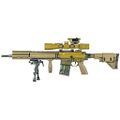Kalean Military Modernization Programs
Since 1965, the Kalean Democratic Forces has had a total of three military modernization programs in order to equip the KDF with modern military equipment to replace the increasingly obsolete equipment that were still in service from almost a century ago.
First military modernization program (1965 CE – 1985 CE)
In 1965, realizing the military was severely undermodernized, as the KDF was still using almost century-old muskets and caplock pistols and was just starting to use vehicles as means of transportation, the Executive Council, against the advice of the Legislative Assembly who advised purchasing from other countries, implemented a plan for a series of modernization programs for military equipment. Series One had advisors sent to observe top militaries from aorund the world and report back on their weapons and equipment designs. Series Two implemented a research and development team to design and develop prototype weapons and equipment for use by the KDF. Series Three would test and determine the applicability of the designs, in which any entrants achieving performance 100% better than the baseline for a successful weapon would be sent back to Series Two. Successful weapons designs from Series Two and Three were the Pū Laipala Advanced Combat Rifle Type 12 (PLACR or just ACR-12), a prototype flechette-firing assault rifle, and the Pū Panapana Type 5 (commonly referred to as Pū or Type 5), a semi-automatic pistol. The only satisfactory design for a military vehicle was the Mea Lawe Pūʻali Koa (MLPK). The two successful designs for artillery were the Pūkuniahi Type 22 (PT-22), a 152 mm towed heavy howitzer with a 32 caliber barrel, and the Pu Kuniahi Liilii Type 9 (PKL), a 81 millimeter mortar. The only successful design for a main battle tank was the Honu Type 2 (HT-2). The only successful military aircraft design was the Mokulele Type 4 (MT-4), a multirole combat aircraft, and was the last design to be implemented. The Series Four, the last of the series, oversaw the mass production and implementation of successful designs. The modernization program took a total of twenty years and ended in 1985. Towards the end of the modernization program, several naval vessels were commissioned to be built over a span of the next ten years. These vessels are the Makai-class Frigate, Ho’omau-class Corvette, and Lanakila-class Gunboat.
Second military modernization program (1995 CE – 2005 CE)
Ten years after the first military modernization program, a second one was initiated to limit vulnerabilities in the KDF's abilities. A series of designs were built focused on aerial defense, ranged combat, and increased infantry maneuverability. The GDF 4, 35 mm twin cannon is a towed anti-aircraft gun, Hoki MLRS, a self-propelled multiple rocket launcher, the Lāpaki LMV, a 4WD tactical vehicle, the WW-11, a multipurpose attack helicopter, and the EE-11, an amphibious armored personnel carrier, were all developed over a ten year period as part of this program. Unlike the first program, the names of the new designs were simplified.
Third military modernization program (2005 CE – 2008 CE)
Following the completion of the second military modernization program, a third one was implemented, though much shorter than the previous two. This one was to focus on increasing the number of firearms to be used by ground units and to phase out the aging assault rifle currently being used. Out of a dozen prototype designs, only two successfully made it to the production stage: the Apekalmoa Marksman Rifle, named after Kalea Apekalmoa, or AMR; and the Pū Laipala Advanced Combat Rifle Type 16, also known as the PLACR-2 or ACR-16. The AMR is a semi-automatic designated marksman rifle and is chambered for 7.62×51mm. The PLACR-2 or ACR-16 is a modular assault rifle chambered for 5.56×45mm. Both rifles entered into service the following year in 2009 after the modernization program ended.














